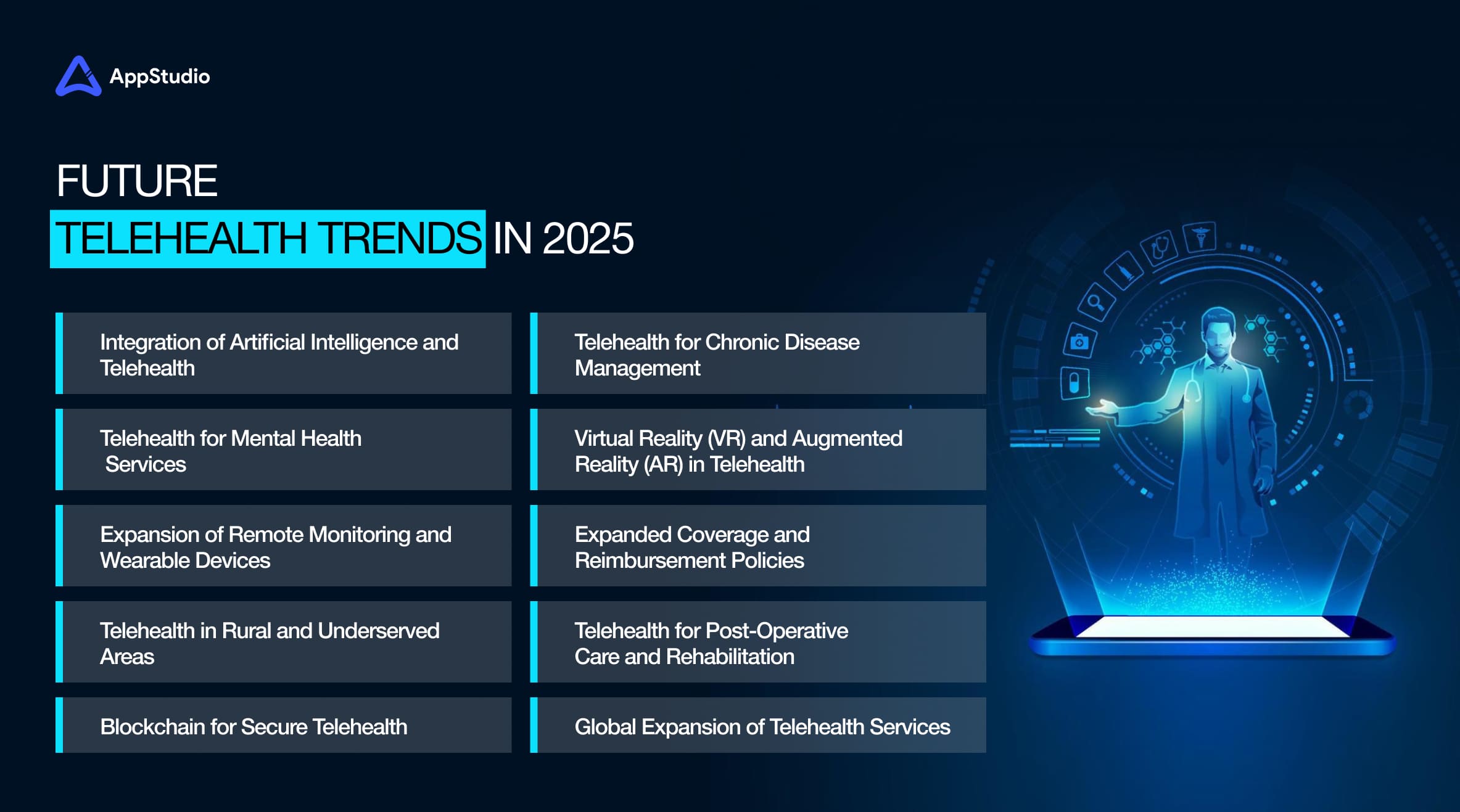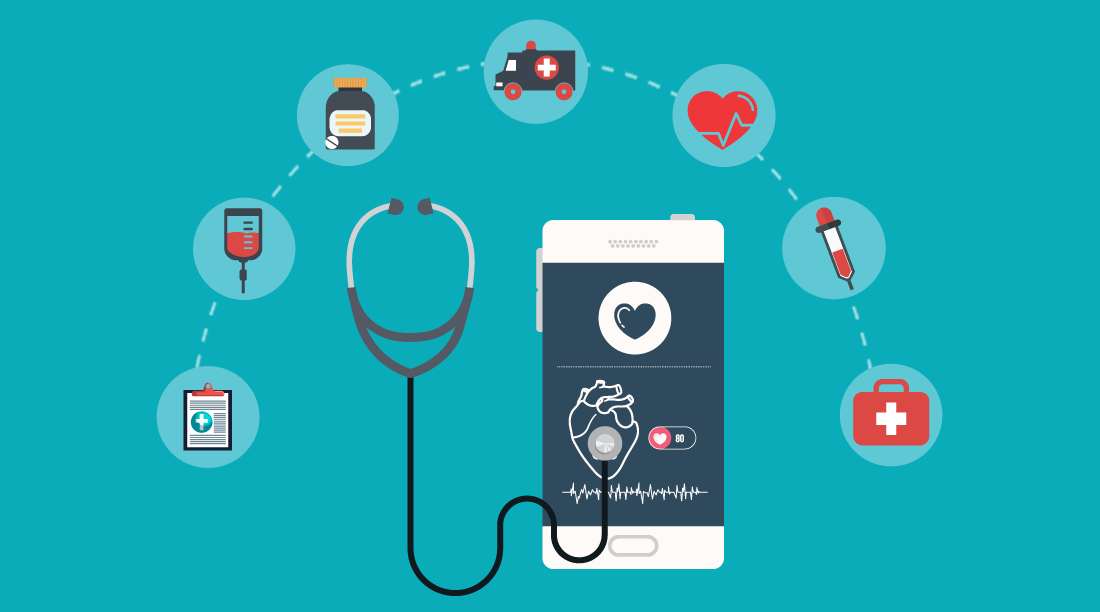Telehealth has fundamentally transformed the way we think about healthcare delivery. Over the past few years, its rapid growth has significantly altered the healthcare landscape, allowing patients to access medical services from the comfort of their own homes. As we approach 2025, the future of telehealth is becoming more integrated into mainstream healthcare systems, providing opportunities to improve access, quality, and cost-effectiveness. In this blog, we’ll explore what telehealth is, where we currently stand, and the top 10 telehealth trends that will shape the future of telehealth in 2025.
What is Telehealth?
Telehealth refers to the use of digital information and communication technologies, such as computers, mobile devices, and telecommunication systems, to provide healthcare services remotely. This includes services like virtual doctor’s appointments, remote patient monitoring, mental health consultations, and even chronic disease management. Telehealth enables patients to connect with healthcare providers without needing to be physically present, making healthcare more accessible and convenient.
This innovation has become especially crucial in the wake of the COVID-19 pandemic, where telehealth allowed many patients to receive care safely while minimizing the spread of the virus. Now, as the healthcare industry continues to evolve, telehealth is here to stay, expanding its role across various healthcare sectors.
Related reading: Top 10 Mobile App Features in Healthcare
Where Are We Standing Now: General Telehealth Market Trends
The telehealth market has grown exponentially over the last few years, driven by several factors. Firstly, the COVID-19 pandemic accelerated the adoption of telehealth services, as many healthcare systems and patients were forced to pivot to virtual care. According to the American Telemedicine Association (ATA), telehealth usage surged by 154% in 2020 alone. This growth was largely due to the increased demand for remote consultations, mental health services, and chronic disease management.
Telehealth is no longer just a niche service; it has become an integral part of healthcare delivery. While many services are still primarily limited to virtual consultations, telehealth trends are pointing towards a future where a wide range of healthcare services can be offered remotely. These include tele-dentistry, tele-physical therapy, and even remote surgeries using advanced robotics.
Currently, telehealth is also becoming more widely accepted by insurance providers, with more plans covering telehealth consultations as part of their offerings. Additionally, the regulatory landscape is evolving, with changes in policies that aim to support telehealth adoption, including expanded reimbursement policies and more flexibility in licensing requirements.
However, despite these advancements, telehealth is still in the early stages of its growth. In particular, barriers such as broadband access in rural areas, inconsistent reimbursement policies, and limited patient awareness about telehealth services remain areas that need attention.
Future Telehealth Trends in 2025

As we look ahead to 2025, the future of telehealth will be shaped by technology, regulation, and patient demand. The following telehealth trends are expected to transform how healthcare is delivered in the coming years.
1. Integration of Artificial Intelligence and Telehealth
Artificial intelligence (AI) is poised to play a pivotal role in the future of telehealth. By 2025, AI will be fully integrated into telehealth platforms to improve the diagnostic process, enhance patient triage, and support healthcare providers in delivering more accurate, personalized care. AI-powered tools will be used for everything from analyzing medical data and interpreting imaging results to providing virtual health assistants that can guide patients through consultations or help monitor chronic conditions.
The incorporation of AI into telehealth platforms will increase efficiency, reduce errors, and create a more streamlined healthcare experience. For instance, AI algorithms could help doctors analyze patient data more quickly, enabling faster diagnosis and more accurate treatment plans.
Related reading: What Is Interoperability in Healthcare? – A Complete Guide
2. Telehealth for Mental Health Services
Telehealth has already made a major impact in the mental health space, and this trend is expected to expand significantly by 2025. Virtual consultations with therapists, psychiatrists, and counselors have become more common, helping to address the increasing demand for mental health services.
In 2025, we will see more telehealth platforms offering a variety of mental health services, such as cognitive behavioral therapy, support groups, and psychiatric care, all through virtual channels. The telehealth trends in mental health will focus on breaking down the stigma associated with seeking help, offering convenience, and ensuring better accessibility for those in need.
Want to build your mobile platform for mental health? AppStudio can help you. With expert mobile app developers in hand, we can help you build that revolutionary online platform that you have always wanted.
3. Expansion of Remote Monitoring and Wearable Devices
One of the most significant telehealth trends for 2025 is the widespread use of wearable devices and remote monitoring tools. These devices will continuously collect data such as heart rate, blood pressure, oxygen levels, and sleep patterns, allowing healthcare providers to monitor patients’ health in real-time.
By 2025, remote monitoring will be essential for managing chronic conditions such as diabetes, hypertension, and cardiovascular disease. These devices will provide healthcare professionals with ongoing insights into a patient’s health status, allowing them to adjust treatment plans and intervene proactively when necessary.
4. Telehealth in Rural and Underserved Areas
Telehealth’s ability to bring healthcare services to rural and underserved communities will continue to be a major focus in 2025. With advancements in broadband infrastructure, more people in remote areas will be able to access high-quality care through telehealth platforms.
In the coming years, telehealth will reduce geographic barriers to care, allowing patients in rural regions to connect with specialists, primary care providers, and mental health professionals without needing to travel long distances. This telehealth trend will improve health outcomes by ensuring that rural and underserved populations can access timely care.
5. Blockchain for Secure Telehealth
As more patient data is shared and stored online, ensuring the privacy and security of this information will be paramount. Blockchain technology is expected to become a critical part of telehealth platforms by 2025. Blockchain will provide a secure, decentralized system for storing and managing patient data, making it less vulnerable to cyber threats.
With blockchain, patients will have more control over their health data, allowing them to grant or revoke access to their personal information at any time. This added layer of security will help increase trust in telehealth services, which is essential for broadening adoption and ensuring compliance with privacy regulations.
6. Telehealth for Chronic Disease Management
Telehealth’s role in managing chronic diseases will continue to grow in importance. In 2025, we can expect more telehealth platforms to offer comprehensive, ongoing management of chronic conditions such as asthma, diabetes, and heart disease.
Remote consultations, coupled with wearables and AI, will enable healthcare providers to monitor patients’ conditions in real time, adjust medications, and offer personalized care plans that reduce the need for frequent in-person visits. This telehealth trend will help improve patient outcomes by ensuring continuous, tailored care for those with chronic conditions.
7. Virtual Reality (VR) and Augmented Reality (AR) in Telehealth
By 2025, virtual reality (VR) and augmented reality (AR) will be integrated into telehealth systems, enhancing everything from patient education to surgical planning and rehabilitation. AR could be used to guide patients through physical therapy exercises, while VR may help physicians simulate medical procedures or train new healthcare providers remotely.
In the future of telehealth, these technologies will offer more immersive and interactive experiences, improving both the quality and effectiveness of virtual consultations.
8. Expanded Coverage and Reimbursement Policies
As telehealth becomes an increasingly common form of healthcare delivery, insurance companies and government programs will expand coverage for telehealth services. By 2025, telehealth consultations, remote monitoring, and other virtual services will be reimbursed at higher rates, making these services more accessible to a larger population.
Governments and insurers will adapt their policies to accommodate the growing demand for telehealth, creating a more supportive financial environment for both patients and healthcare providers.
9. Telehealth for Post-Operative Care and Rehabilitation
Telehealth will play an essential role in post-operative care and rehabilitation in the years to come. By 2025, patients recovering from surgery or major treatments will be able to receive virtual check-ins with their healthcare providers to monitor progress, discuss symptoms, and receive guidance on exercises or therapies.
This shift will reduce the need for hospital visits and physical checkups, which will not only lower costs but also offer a more convenient and efficient way to manage recovery.
10. Global Expansion of Telehealth Services
As technology continues to improve and telehealth becomes more widespread, we can expect telehealth trends to expand globally. By 2025, telehealth will be commonplace in both developed and developing countries, providing more people with access to essential healthcare services. This global expansion will help reduce health disparities, particularly in regions with limited access to medical professionals.
Want to expand your telehealth service globally with an online platform? Get in touch with experts at AppStudio – a leading mobile app and web app development company.
Related reading: Software Architecture for Healthcare Apps
Conclusion
As we look ahead to the telehealth future trends in 2025, it’s clear that telehealth will continue to play a vital role in reshaping the healthcare landscape. From AI-powered diagnostics and remote monitoring to expanded access for rural populations and virtual mental health services, the future of telehealth is bright.
With the rise of wearable technology, blockchain security, and new forms of virtual care, we can expect telehealth to become an increasingly integral part of the healthcare system. As these trends continue to evolve, telehealth will not only enhance patient care but also increase the efficiency and effectiveness of healthcare delivery worldwide.
By embracing these telehealth trends, healthcare providers can improve the patient experience, reduce costs, and ensure better outcomes for patients in 2025 and beyond. The future of telehealth is here, and it’s full of promise.
Frequently Asked Questions
Telehealth refers to the use of digital technologies like video calls, mobile apps, and remote monitoring devices to provide healthcare services remotely. It allows patients to connect with doctors, therapists, and other healthcare professionals without needing to be physically present in a clinic or hospital. Telehealth services can include virtual consultations, mental health therapy, remote monitoring of chronic conditions, and more. By using devices like smartphones, computers, and wearables, telehealth makes healthcare more accessible and convenient.
The telehealth market has seen rapid growth in recent years, largely accelerated by the COVID-19 pandemic. Virtual consultations, mental health services, and chronic disease management have become key components of telehealth offerings. Many insurance providers are now reimbursing telehealth services, expanding access to care. However, challenges such as inconsistent reimbursement policies and broadband access in rural areas still remain. Overall, telehealth is becoming a permanent fixture in healthcare, with increasing adoption among both providers and patients.
By 2025, we can expect telehealth to integrate several emerging technologies. Key trends include the use of artificial intelligence (AI) to enhance diagnoses and treatment plans, the expansion of wearable devices and remote monitoring tools to track patient health in real-time, and the growing role of virtual mental health services. Additionally, blockchain technology will be crucial for ensuring the security and privacy of patient data. Telehealth will also play a significant role in managing chronic diseases and providing access to care in underserved areas.
Artificial intelligence will become a cornerstone of telehealth by 2025. AI will assist in diagnosing patients more accurately by analyzing medical data, lab results, and even medical imaging. It will also help healthcare providers make better-informed decisions, personalize treatment plans, and offer more efficient care. For instance, AI could assist with patient triage during virtual consultations, speeding up the diagnostic process. As AI continues to evolve, it will play a pivotal role in improving the overall quality and efficiency of telehealth services.
Telehealth is a game-changer for patients in rural and underserved areas, where access to healthcare providers is limited. By 2025, telehealth will be a vital tool for connecting patients to medical professionals without requiring long travel times. With expanded broadband access, more people will be able to access virtual consultations, mental health services, and specialized care that might otherwise be unavailable to them. This will help bridge healthcare disparities, providing quality care to populations that might struggle to access traditional in-person services.
By 2025, telehealth will be a key component of healthcare delivery around the world. It is already proving to be beneficial in both developed and developing countries, providing access to care in remote areas and helping alleviate healthcare system strains. Telehealth will continue to expand globally, allowing patients in low-resource regions to connect with specialists and receive care that may not be available locally. By making healthcare services more accessible, telehealth can help address global health inequities and improve overall health outcomes.







